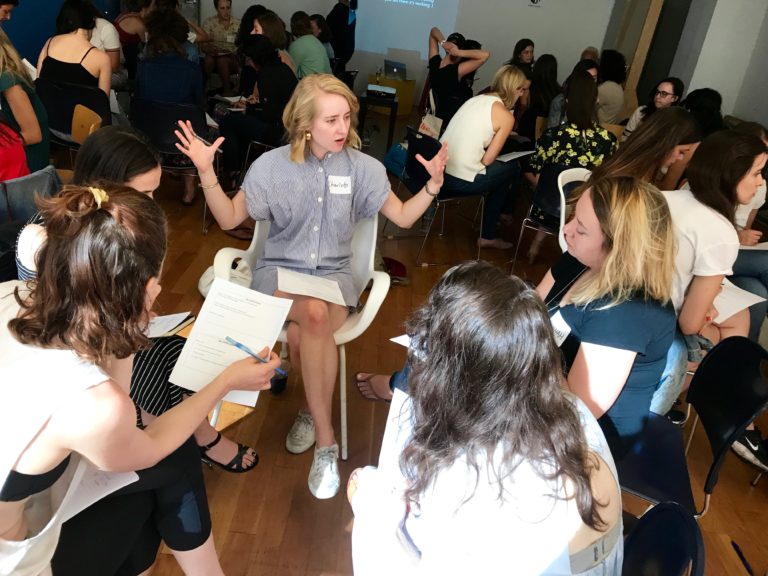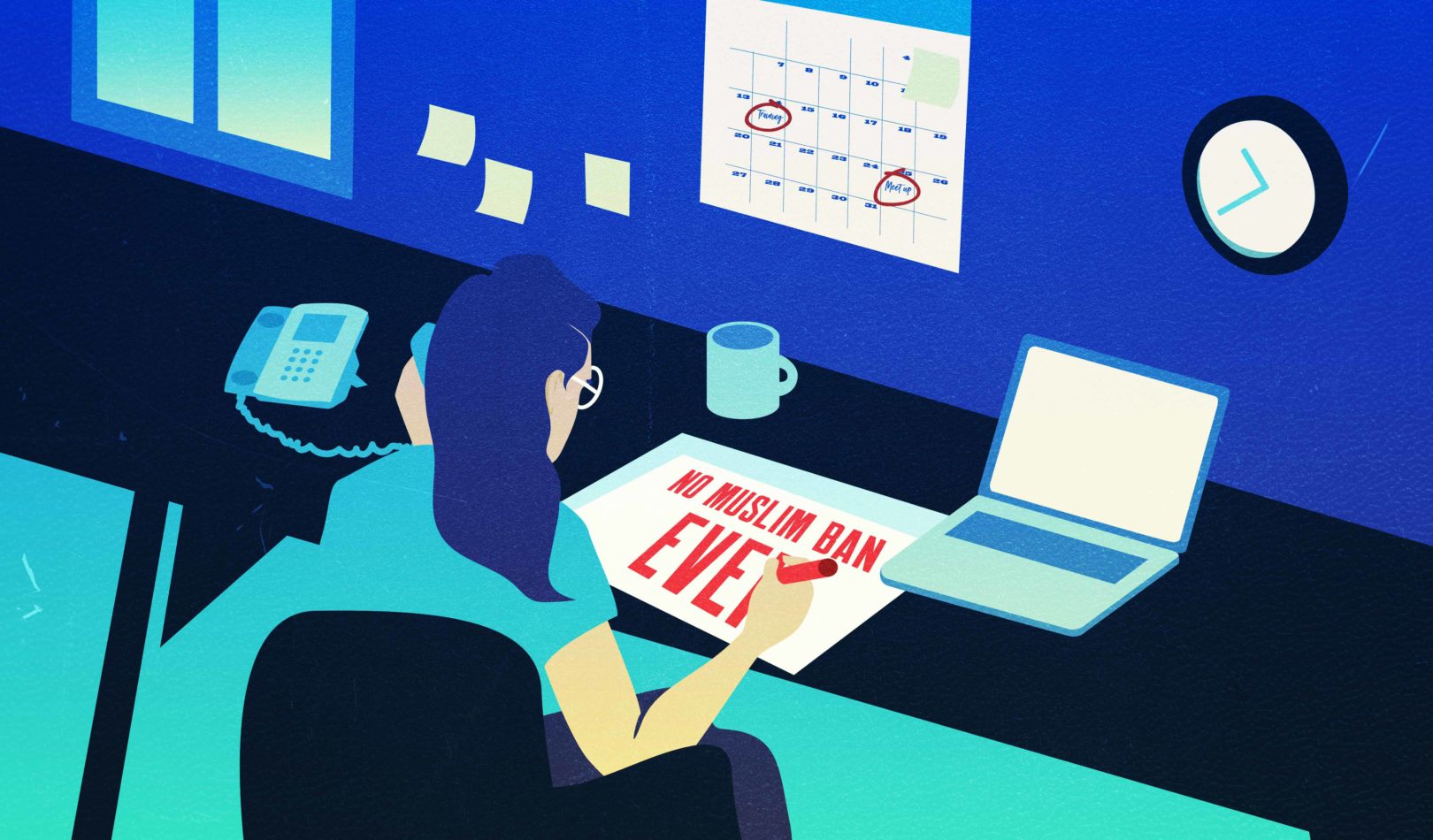How the decentralized, digitized tactics of the Resistance have made women the movement’s driving force.
By Emma Gordon
Illustration by Grace Molteni
Photo courtesy of Broad Room
It’s been almost a year since President Donald Trump’s electoral college win forced many progressives out of their willful Obama-era complacency. Less than a week after Trump’s inauguration and the subsequent Women’s March, the Washington Post conducted a poll asking adults whether, as a result of the election, they planned to change their level of political involvement over the following year. A quarter of the recipients indicated a desire to increase their political activity, and among Democratic women, this number rose to 40 percent. The data, which was corroborated by research from the Women’s March, suggested that in resisting Trump, gathering support wouldn’t be the problem. Instead, the question would be whether those angered by Trump’s administration would be able to organize their frustration into sustained, effective opposition to his policies.
Over the last 11 months, activists and community organizers have worked doggedly to clarify and publicize the tools civilians need to make their voices heard by government officials. Although a few of these organizations—including Indivisible and MoveOn.org— have significant followings, the capital-R “Resistance” is notable for its intentional decentralization. Like the Republican Tea Party movement that the Resistance (ironically) emulates, Resistance groups have not consolidated under a monolithic leadership, instead focusing on narrow audiences to whom they can assign specific, tangible goals.
One arena in which this decentralization has played out is in the email newsletter. Newsletters have seen a surprising resurgence in recent years. Although they have always been popular as advertising methods, the appeal of services such as TinyLetter and MailChimp to individuals unattached to businesses have allowed newsletters to gain traction in the private sector. New York Times reporter Teddy Wayne put it best in his 2016 headline: “What is a TinyLetter? Like Ye Olde Blog, But Less Public.”
Email newsletters may be the closest tactic to grassroots dissemination available online. They circumvent public platforms that may have ulterior motives (here’s looking at you, Facebook) and deliver content straight to an audience. Newsletters incorporate market values of both push and pull media strategies: Readers request to subscribe, pulling themselves into the content, and in doing so choose to receive push content directly to their inboxes where they can’t look away.
The number of Resistance-themed email newsletters a person can subscribe to feels infinite. A “nonexhaustive” list published in February by The Nation featured 75, and that was more than eight months ago. But simply because these newsletters are sent out does not mean they are opened, and being opened does not always translate into action. Nonetheless, recent victories by the Resistance, including sustained pushback on Trumpcare and the Muslim ban, suggest that these means have been and will continue to be effective in spreading information and inspiring action.
BUILDING COMMUNITY ON AND OFFLINE
With their private channels of communication and unglamorous recommendations to make calls and send money, newsletter followers are mostly invisible. Veteran grassroots organizer LA Kaufmann believes that these faceless figures are mostly women.
In a July article for the Guardian, Kaufmann, author of Direct Action: Protest and the Reinvention of American Radicalism (Verso Books, February 2017), argued, “Though hard data isn’t available, all indications are that women predominate in the resistance movement’s most distinctive expression: the thousands of small, local groups that have sprung up all around the United States.” According to a March study Kaufmann cites from DailyAction.org, 86 percent of calls to congressional offices—the most frequently recommended action in activist newsletters—were made by women.
Friends Amelia Miazad and Kara Ganter started Wall of Us in November of 2016 with their family and friends in mind. Miazad and Ganter are both lawyers.
“[Miazad and Ganter] really thought of [the organization] as a personal project,” said Wall of Us’ technology chair Nicole Neditch. “It was a way to keep themselves engaged and informed and strategic in the actions they were taking.”
What started as an email list of 2,000 people from Miazad’s and Ganter’s social networks expanded quickly to 40,000 and then 70,000—the number of people the newsletter reaches today. Every Sunday night, Wall of Us recommends four actions to its subscribers. Often the actions include calling representatives, which is made easier for readers with the inclusion of phone numbers and personalized scripts. Other actions have included supporting marginalized groups through protest, donating to communities in crisis and educating oneself to fight pernicious prejudice. Respondents to a recent survey overwhelmingly indicated that taking actions suggested by Wall of Us was the first time they’d been consistently involved in activism. Ninety-five percent of the subscribers (not to mention, everyone on the founding team) identified as female.
What is it about the newsletter format that has been so successful in attracting and retaining women? One asset may be the newsletter’s tone. In an age where women face harassment online, the one-way communication of email allows for intimacy without fear of backlash from trolls. Because of newsletters’ opt-in requirement, their writers aren’t expected to cater to a universal reader; instead, they can write honestly to a targeted, supportive audience.
Like Miazad and Ganter, Monica Klein, Elana Leopold and Anna Poe-Kest started the Broad Room with their own social circle in mind. All three work in politics in New York City: Klein and Leopold work for Mayor Bill de Blasio and Poe-Kest works for New York City Hall.
“We are women in our 20s who talk to other women in their 20s, so we know what they’re curious about,” says Leopold. “We know that come voting day we’ll get texts asking, ‘Do I need my ID to get to the polls? What’s my polling site?’ And we use this information to make sure we’re delivering useful content that will help these women become more politically active.”
After the election, Klein, Leopold and Poe-Kest wanted to empower other young women in New York City to take localized actions to improve their city. They knew their careers gave them unusual access to knowledge and public officials whose expertise could benefit people in other industries. Who better to delve into the nuances of New York’s upcoming vote over a possible constitutional convention or to highlight the most hotly contested congressional races than three women who have worked on the inside? The Broad Room’s weekly email—which its founders prefer to call an action letter rather than a newsletter because of its result-oriented content—is carefully curated to appeal to its audience with concise, digestible text, bright colors and gifs throughout.

Talya has been a Broad Room subscriber since its founding. A friend of Klein’s, Talya has felt empowered by the accessibility of the action letter. “I think they get the millennial age,” says Talya. “Their headlines are funny, and [the action letter] is aesthetically appealing, which matters when I’m commuting and my brain is going in 100 different directions.”
At Wall of Us, Neditch also focuses on language. She explained that keeping the newsletter’s tone consistent helps its founders avoid assigning too much meaning to fluctuations in subscriber numbers.
“There are a lot of organizations that are sending out actions,” she says. “People find the voice that speaks to them and stick with it.”
In addition to the familiarity of their format, newsletters also prioritize convenience, an especially important quality for women who are tasked with an unpaid second shift and emotional labor as well as work outside the home. Engagement in democracy presupposes two blocks of time: the first, the time it takes to conceive of an action and the second, the time it takes for said action to be performed. The former is erased by the work of activism newsletters, and while the latter block of time can’t be eliminated entirely, the newsletter can streamline the process.
For Toya, a Broad Room member who recently moved to New York from California, the action letter helped her feel less intimidated by local politics. “It’s a barrier entry to have to do the work of finding an organization to get involved with,” she says. “And then the Broad Room came around and started highlighting specific places I could go to get involved. Now I was only being asked to give a small piece of my time. They had done all the work.”
It is Neditch’s hope that the small pieces of time people give to the actions in a newsletter contribute to the development of budding activists along a “ladder of engagement.”
“At times people might not have time to go to an [in-person] action, but that doesn’t mean they don’t appreciate it,” Neditch says. “If we keep those people engaged through regular phone calls, when the time comes, they’ll be more likely to get engaged on some of the bigger things.”
In the future, Wall of Us hopes to strengthen partnerships with nonprofits that will help it provide localized actions for its subscribers. Later this fall the organization will launch a series of in-person meet-ups across the country where subscribers can interact face-to-face while working with community leaders to “lift up organizations that have been doing this work for a long time,” says Neditch.
The Broad Room supplements its action letter with monthly in-person trainings in New York City by political leaders. Last month’s training was led by Emma Wolfe, the director of intergovernmental affairs for Mayor de Blasio, and offered strategies for community organizing. The Broad Room also hosts networking events in bars around New York City to provide its subscribers with an opportunity to meet in person, perhaps to later “go out and be active together.” At least that’s the hope, Leopold says.
“Other times when you go to networking events, you sort of get lost in the shuffle,” says Toya. “But the camaraderie and atmosphere of the Broad Room feels genuine. I started conversations with five people, and they followed up with me later. Everyone is so friendly, and it feels like that’s because they’re here for the right reasons.”
Although in-person events may not be possible for every subscriber of either the Broad Room or Wall of Us, for those who are able, these meet-ups provide a safe space where women can share experiences, ask questions and learn from each other without fear of outside harassment. Although the subscribers have never met, they are connected by the shared experience of civic engagement spurred by a uniting voice.
How both the digital and in-person functions of these organizations will grow as the Resistance continues its uphill battle remains to be seen. If tweets are the noisy chaos of a school cafeteria, email newsletters are whispers in the library among the bowed heads of people looking to get work done. Anyone familiar with the work of John Hughes can imagine which platform will produce the activists who will be recognized for their work. But anyone who has ever taken their lunch to the library also knows that there is more than one route to driving change. The activism of the email newsletter community may be quiet, but its effects—on both its participants and the issues they’re fighting for—are loud.

Emma Gordon grew up outside of Los Angeles and graduated from Northwestern University. She works in publishing and lives in Brooklyn, where she can frequently be found lost in Prospect Park.
Grace Molteni is a Midwest born and raised designer, illustrator, and self-proclaimed bibliophile, currently calling Chicago home. She believes strongly in a “beer first, always, and only” rule, and is forever seeking the perfect dumpling. For more musings, work, or just to say hey check her out on Instagram.




